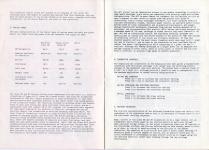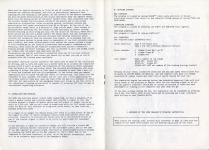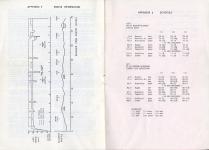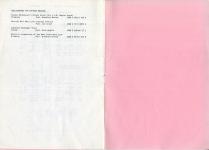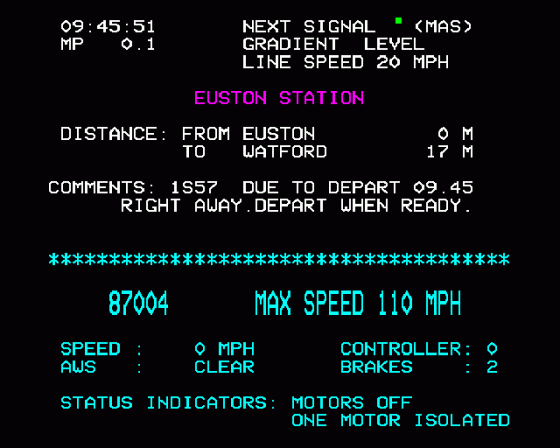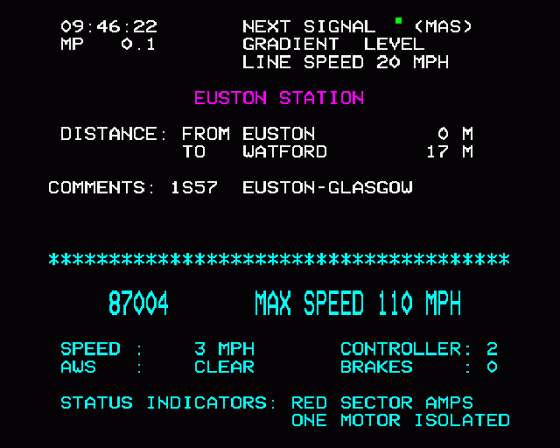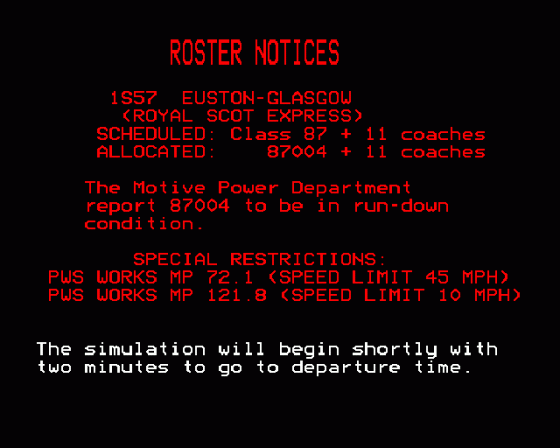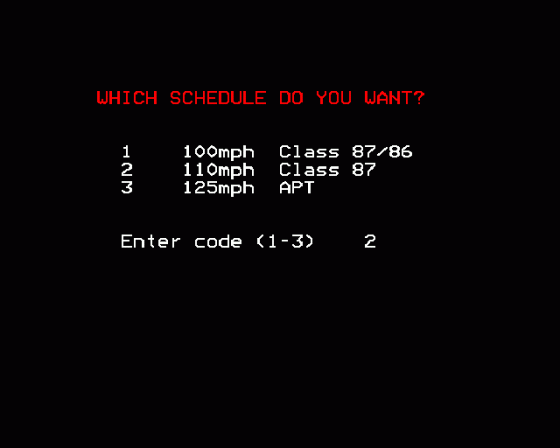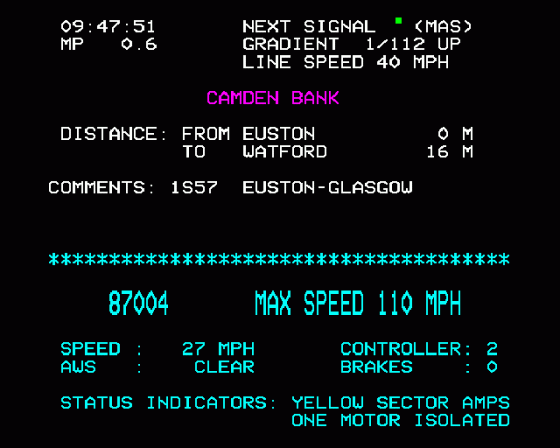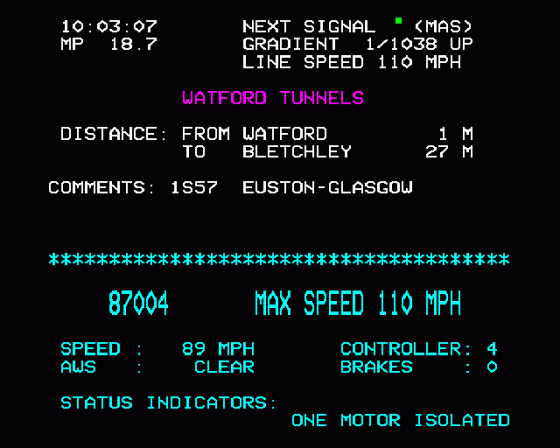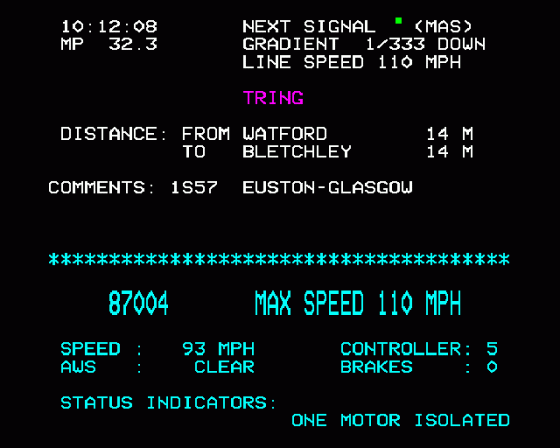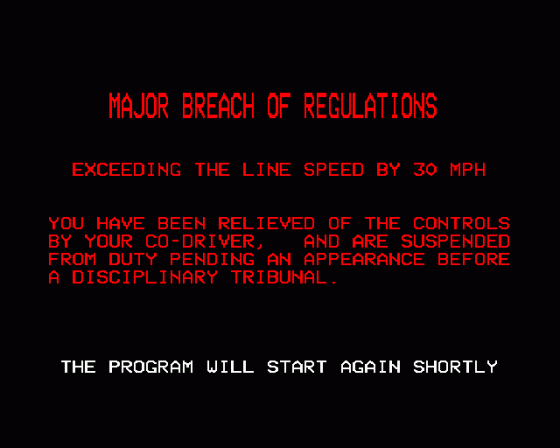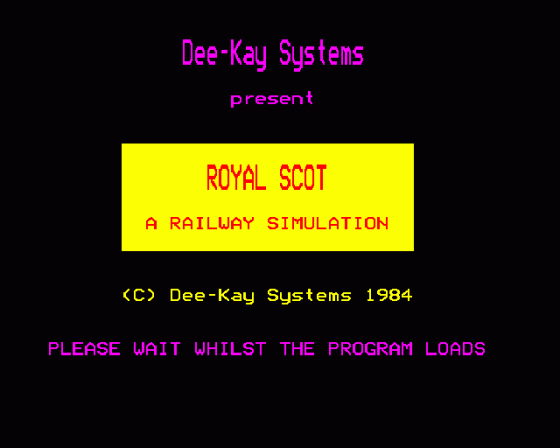
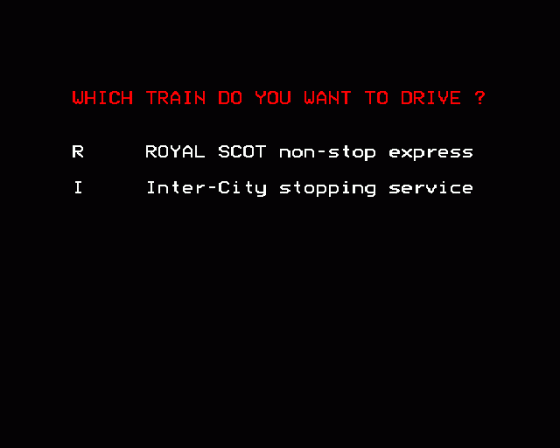

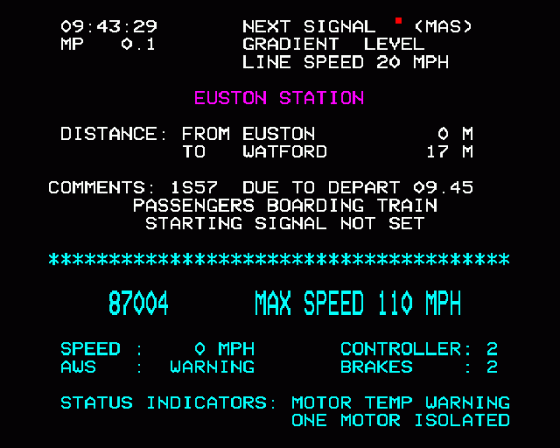
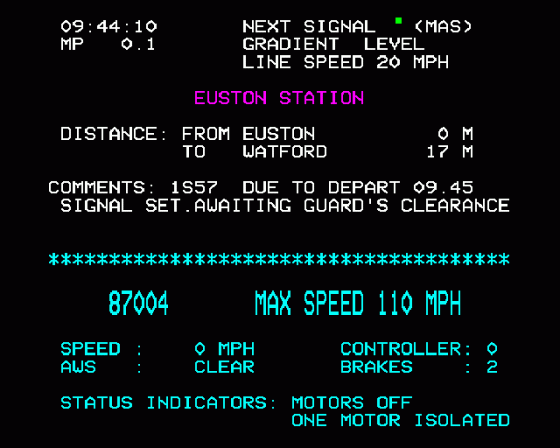
| Genre: | Game: Simulation |
| Publisher: | Deekay |
| Cover Art Language: | English |
| Machine Compatibility: | BBC Model B |
| Release: | Professionally released on Cassette |
| Available For: | BBC Model B & Spectrum 48K |
| Compatible Emulators: | BeebEm (PC (Windows)) PcBBC (PC (MS-DOS)) Model B Emulator (PC (Windows)) |
| Original Release Date: | 1st January 1984 |
| Original Release Price: | £7.50 |
| Market Valuation: | £1.34 (How Is This Calculated?) |
| Item Weight: | 64g |
| Box Type: | Cassette Single Plastic Clear |
| Author(s): | - |
Variant Items
There are 0 other items featuring this same game (that we know about!). Click any of them for their details.
Active Auctions
Closed Auctions
Buy It
Unfortunately no-one is currently selling this item.
Auction Price Watch
Worried you're being ripped off? Closing prices on eBay can help you decide what a reasonable price is for a particular item.
Full Instructions
Introduction
The title 'Royal Scot' was first conferred on an Anglo-Scottish express by the London, Midland and Scottish Railway in 1927. The train has long been regarded as the premier service on the West Coast main-line between Euston and the north, and since completion of the electrification of this route in 1974 has been the spearhead of the 'Electric Scots' service between London and Glasgow.
In this simulation, you can drive the Royal Scot between Euston and Crewe with either a Class 86/2 or Class 87 locomotive, or, to savour what might have been, one of the formations of the Advanced Passenger Train (APT). In addition to the non-stop Royal Scot, there is also the opportunity to drive a Liverpool bound Inter-City Executive express with pick-up stops at Watford Junction and Rugby, and there is a choice of schedules reflecting the raising of the line-speed limit for locomotive-hauled trains from 100mph to 110mph on the introduction of the speeded-up WCML timetable in May 1984.
Display Format
The simulation is presented as a two-part display on the television screen: the upper section giving information a driver would have from visual observations and his background knowledge of the route, and the lower section being a monitor of the locomotive controls and performance.
The Route And Line Speed Restrictions
The main features of the WCML between Euston and Crewe are shown in Appendix 1. After leaving the London suburbs at Watford, the line climbs over the Chilterns at Tring summit, and then runs through undulating farmland to Rugby and the Vale of Trent before the steep descent down Madeley bank into Crewe. The route is electrified at 25kV a.c. throughout, and there are neutral sections in the overhead line supply at the locations marked in Appendix 1. At these, the locomotive power controller will automatically be run off, and there will be a short delay before power can be re-applied.
In addition to the normal speed restrictions, there may be temporary restrictions due to engineering work on the track at the locations shown. Details of these 'permanent way slacks' will be given at the start of the simulation, and a reminder will also be given during the run as your approach these and other reductions in the permitted line speed (this 'advance warning' commencing 1.5 miles before the pws works and the major restrictions at Rugby and Crewe, and one mile before all other reductions).
Schedules And Train Formations
The timings of the Royal Scot (with reporting number 1S57) and the Liverpool Inter-City express (1F11) are given in Appendix 2 for the different schedules (100mph running with a nominal 13 coach train weighing 455 tons, 110mph running with an eleven coach flyer of 385 tons, and 128mph running with APT).
On all schedules, the initial section out to Watford Junction is particularly tightly timed, and with the Liverpool train you will need to brake smartly to avoid losing time at the Watford pick-up stop. The overall objective is to run to schedule so as not to create pathing problems for either yourself or other trains, and as such your passing times at the major timing points of Rugby and Crewe will contribute to your score in the driver assessment at the end of the simulation.
The locomotive-hauled trains are assumed to be composed of the latest Mk3 coaching stock. The number of coaches may deviate from that scheduled, and you will be given details of the actual formation of your train, together with other information, on the Roster Board at the start of the simulation.
Motive Power
The main characteristics of the three types of motive power available are given below, all types receiving power from the overhead line supply at 25kV.
| Modified Class 86 |
'Royal Scots' Class 87 |
APT-P | |
|---|---|---|---|
| BR Designation | 86/2 | 87/0 | 370 |
| Numbers available in simulation |
862D4-261 | 87001-035 | 370001-7 |
| Builder | BR/EE | BREL | BREL |
| Introduced | 1973 | 1973 | 1979 |
| Axle type | Bo-Bo | Bo-Bo | Bo-Bo |
| Weight (tons) | 84 | 82 | 68 |
| Continuous rated horsepower |
4040 | 5000 | 4000 |
| Maximum speed (mph) | 100 | 100/110 | 125(155) |
The Class 86 and 87 designs evolved from experience with the early a.c. electric locomotives of types AL1-5 (later BR Classes 81-85). The Class B6 locomotives introduced in 1965 has a major difference to their predecessors in that their traction motors were suspended directly on the axles rather than being mounted on the locomotive frames. The resulting increase in unsprung weight was, however, found to give poor riding and cause excessive track wear at speed, and as a consequence from 1973 onwards 58 of the original 100 locomotives were upgraded for high speed running by the addition of flexicoil springing and special resilient wheels (the locomotives so modified becoming sub-class 86/2).
The later Class 87 locomotives reverted to frame-mounted motors to overcome the problem of unsprung weight, and with four GEC motors giving a continuous traction rating of 5000hp, these locomotives are the most powerful on British Rail. There are, however, problems of adhesion with only four axles, and this makes the type particularly prone to wheelslip.
Until 1984, the Class 86/2 and 87 locomotives were used near indiscriminately on the principal 100mph West Coast expresses, but with the raising of the line speed limit to 110mph in May of that year, only Class 87 locomotives fitted with specially modified pantographs were rostered to haul the fastest services (the locomotives having been geared for running at this higher speed on construction).
The APT project was an imaginative attempt to use modern technology to produce a high speed passenger train which was compatible with existing track and railway infrastructure. The APT is most famous (or infamous) for its ability to tilt by up to nine degrees, to take curves at speeds some 40% greater than those of conventional trains without passenger discomfort, but other advanced features included hydrokinetic brakes, thyristor power control, an advisory speed display system based on track transponders and on-board microprocessors, and weight-saving construction techniques.
Developed from the gas turbine powered APT-E prototype, the pre-production 25kV electric ATP-P series units were designed for a maximum speed of 155mph, although in normal service they were limited to 125mph. APT had an inauspicious launch, and following technical problems and difficulties in coping with the severe weather in the winter of 1981, the concept of production versions of the trains was virtually abandoned. If they had entered squadron service, the most likely formation would have been 1+10 (1 power car and 10 trailers), and as such in the simulation we have available the so-called 'low power' configuration of APT-P consisting of one power car and eleven trailers. Although the 4000hp developed by a single power car is adequate for 125mph running on level track, there is little power in reserve and you will find it difficult to maintain high speed on adverse gradients.
Locomotive Controls
For simplicity, all locomotives in the simulation have been given a standardized controller with five power settings (1-5) rather than the differing control systems of the originals (see next section). The brakes have a similar range of 0 (off) to 5 (full on), although position 5 should be used in emergencies only, the maximum appliction in normal service being position 4.
On the BBC:
Press the > key to increase the controller setting.
Press the < key to decrease the controller setting.
On the Commodore and Spectrum computers:
Press P to increase the controller setting.
Press O to decrease the controller setting.
On all computers:
Press X to increase the brake setting.
Press Z to decrease the brake setting.
Driving Technique
The tractive characteristics of the different locomotive types are realistically reproduced in the simulation and as such it is necessary to become familiar with the individual handling responses.
Basic control of the Class 86 and 87 locomotives is by a high tension voltage transformer which feeds power to the traction motors on each axle through semi-conductor bridge diodes. On the actual locomotives, there are 38 tappings on the transformer winding, and the one selected may be held steady, moved a notch up or down, or run up or down according to the position of the master controller. Our adoption of a controller with just five direct power settings of necessity gives a coarser degree of control, but in practice there will be little difference in performance as many drivers notch up in stages using the run and hold positions rather than stepping through the tap settings individually.
Power must be applied gradually on Class 86 and 87 locomotives so as not to overload the traction equipment, and this is particularly important when starting off and running at low speeds. As the current to the motors increases, you wil be given notification on the status indicators when the ammeter needle moves into the yellow sector of the motor current dial. This indicates only that the current exceeds the continuous rating of the motors and is the normal condition of acceleration (often occupying several controller notches and persisting on full power acceleration up to 80 or 90mph).
At the top of the yellow sector range, there is a warning of 'high yellow maps'. Such current is necessary when starting of, but should be used sparingly in normal running. Further notching up will bring you into the red sector of the dial, where for a brief period you can use a boost current for extra power, but any increase in the controller setting will activate the main roof-mounted contactor which isolates the locomotive from the overhead line supply. It is assumed that the driver vigilance system is being reset by depression of the foot activator pedal once a minute, and other effects which occur behind the scenes include a stage of field weakening on the Class 87 locomotives and automatic compensation for wheelslip. Both Class 85 and Class 87 locomotives have electric rheostatic braking through the motor windings, and this is blended in with the normal train air brakes once the power taps have been run off.
Occasionally, you may be allocated a locomotive with one of its four traction motors isolated, and if this occurs you should try as best you can to run to schedule with the limited power available.
The modern thyristor control system of APT takes care of many of the intricacies of driving, and to vary the power all a driver need do is to move the controller between notch 0 and 5 to select the proportion of the tractive effort available from the motors at that particular speed. The on-board microcomputers will give a warning if either the train or line speed is exceeded by more than 3mph, or if there are problems with the tilt mechanism. In the latter case, you should immediately slow to below 100mph and revert to conventional line limits for the remainder of your journey.
The brakes are set such that a full application of the normal service brake will stop the train from 125mph in a distance of about 2,000 yds, but application of the emergency brake will bring in the full force of the nydrokinetic braking system which is capable of stopping APT from 155mph in conventional signalling distances.
Signalling And Braking
The WCML has multiple aspect colour light signalling, so that a sequence of at least a double yellow and a yellow signal will precede a signal at red. The distance between a signal at double yellow and the signal at danger can be as short as 2,200 yds, and you will need to brake hard with the full normal service brake for much of this distance to bring your train safely to rest from its maximum permitted speed.
If a signal is at danger, you should bring your train to a stop within 35 yds of the signal in order to obtain telephone instructions from control about the situation. Similarly in stations, you should draw up in the platform within 35 yds of the starter signal in order to be correctly positioned for passenger loading.
As you approach a signal at caution or danger you will receive a visual AWS (Automatic Warning System) indication on the instrument panel, and in the case of the BBC computer an audible alarm. This must be acknowledged within six seconds by pressing the Space Bar on the BBC computer or the 0 (zero) key on the Commodore or Spectrum computers, or else, as on the actual locomotives, there will be an automatic application of the emergency brake.
Getting Started
BBC Computer:
The program is loaded by typing CHAIN"" (note users with Disc or Econet interfaces should first return to the cassette filing system by typing *TAPE and PAGE=&E00).
Commodore 64:
The program is loaded by pressing the SHIFT and RUN/STOP keys together.
Spectrum:
The program is loaded by typing LOAD"scot"
Input Parameters
The required input parameters are:
Train selection:
Type R for Royal Scot
Type I for the Liverpool Executive service
Train schedule:
1 100mph Class 86/2 or 87
2 110mph Class 87
3 125mph APT
Loco number:
Type a number in the range:
86204-261 (Class 86)
87001-35 (Class 87)
370001-007 (APT set number of the leading driving trailer)
Details of your train, locomotive condition and any pws speed restrictions will be given as Roster Board informtion, and the computer will make its random selection of signal checks and other out of course events for your run.
The simulation begins two minutes before the scheduled departure time with your train ready in the platform at Euston. Wait for the starting signal to be set and the guard's clearance (which may of course be delayed if there are late passengers or loading is not complete) and then away you go.
If you want a break during the run, the simulation can be suspended by pressing the H key (for hold), with action restarted by pressing the R key. Otherwise, good driving on your journey North.
A Reminder Of The Line Manager's Standing Instruction
When trains are running late, drivers must endeavour to make up time with due regard to all speed restrictions and the braking capability of the train.
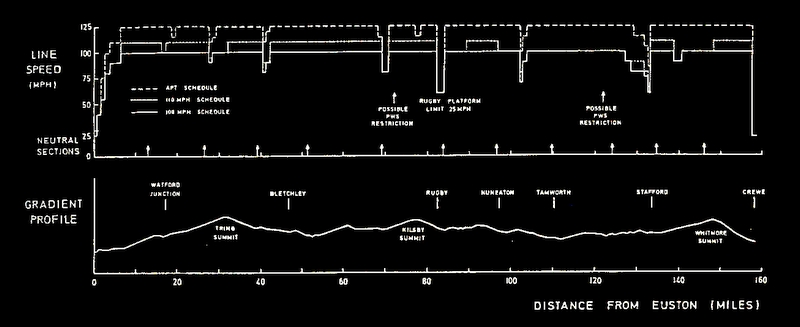
|
Appendix 2: Schedule
1S57
09.45 Euston-Glasgow
(Royal Scot)
| [1] | [2] | [3] | |||
| 0.0 | Euston | dep | 09.45 | 09.45 | 09.45 |
| 17.4 | Watford Jn. | pass | 09.59 | 09.58½ | 09.57 |
| 46.7 | Bletchley | pass | 10.17½ | 10.16 | 10.12 |
| (+2 min recovery) | |||||
| 82.5 | Rugby | pass | 10.42½ | 10.39 | 10.34 |
| 97.1 | Nuneaton | pass | 10.52½ | 10.48½ | 10.43 |
| 110.0 | Tamworth | pass | 11.00½ | 10.56½ | 10.49½ |
| (+2 min recovery) | |||||
| 133.5 | Stafford | pass | 11.18 | 11.14 | 11.03½ |
| 158.1 | Crewe | pass | 11.35½ | 11.30 | 11.18 |
1F11
07.50 Euston-Liverpool
(Inter City Executive)
| [1] | [2] | [3] | |||
| 0.0 | Euston | dep | 07.50 | 07.50 | 07.50 |
| 17.4 | Watford Jn. | arr | 08.05 | 08.04½ | 08.03 |
| dep | 08.06 | 08.05½ | 08.04 | ||
| 46.7 | Bletchley | pass | 08.26½ | 08.25 | 08.21 |
| (+2 min recovery) | |||||
| 82.5 | Rugby | arr | 08.53 | 08.49½ | 08.44½ |
| dep | 08.55 | 08.51 | 08.46 | ||
| 97.1 | Nuneaton | pass | 09.06½ | 09.02 | 08.56 |
| 110.0 | Tamworth | pass | 09.14½ | 09.10 | 09.02 |
| (+2 min recovery) | |||||
| 133.5 | Stafford | pass | 09.32 | 09.27½ | 09.16½ |
| 158.1 | Crewe | pass | 09.49½ | 09.43½ | 09.31 |
Schedules
| [1] | E455 | 13 coach | 100mph |
| [2] | E385 | 11 coach | 110mph |
| [3] | APT | Low power | 125mph |
Bibliography For Further Reading
Diesel Enthusiasts' Pocket Guide (Vol 4 L.M. Region South)
M.Oakley, Publ. Bradford Barton, ISBN 0 85153 405 8
British Rail Main Line Gradient Profile
Publ. Ian Allan, ISBN 0 7110 0875 2
Advanced Passenger Train
G.Body, Publ. Avon Anglia, ISBN 0 905466 37 3
Electric Locomotives of the West Coast Main Line
M.Oakley, Publ. Bradford Barton, ISBN 0 85153 355 8
Screen Designers
The following utilities are also available to allow you to edit the supplied screens of this game:
Cheats
Download
A digital version of this item can be downloaded right here at Everygamegoing (All our downloads are in .zip format).
| Download | What It Contains |
|---|---|
| A digital version of Royal Scot suitable for BeebEm (PC (Windows)), PcBBC (PC (MS-DOS)), Model B Emulator (PC (Windows)) |
Report A Problem
We thank you from the bottom of our hearts if you report something wrong on our site. It's the only way we can fix any problems!
You are not currently logged in so your report will be anonymous.
Add Note
Release Country
Change the country to update it. Click outside of this pop-up to cancel.
Scan Of Selected Article
If you auction an item, it will no longer show in the regular shop section of the site.








